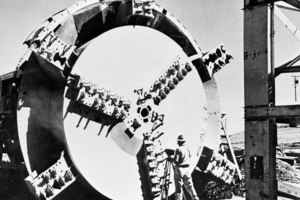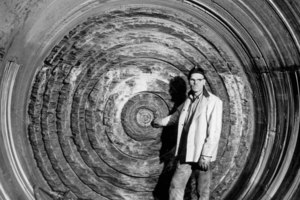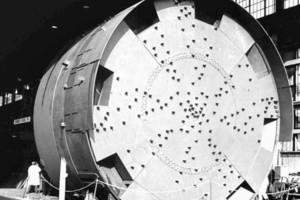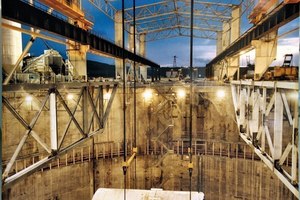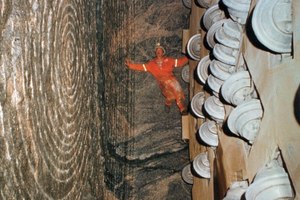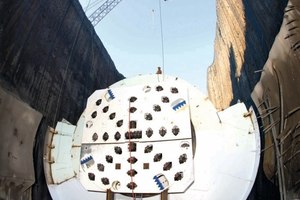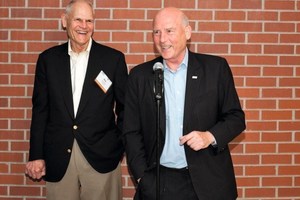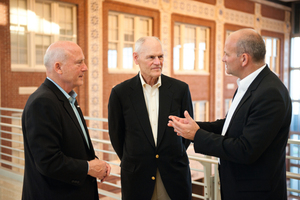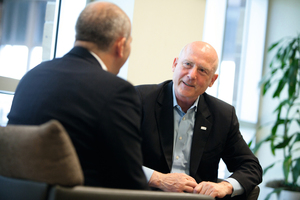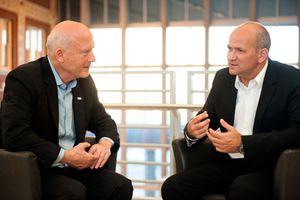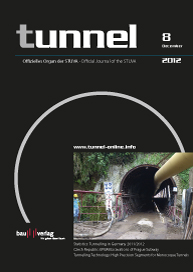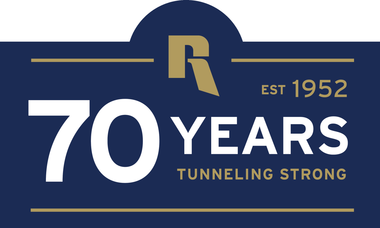60 Years of Tunnelling
In June 2012 the Robbins Company celebrated at the NAT 2012 (North American Tunnelling Conference) in Indianapolis, Indiana/USA 60 years of Tunnelling. Taking this chance, Lok Home found time for an interview with your tunnel magazine editor in chief Roland Herr.
In 1952, James S. Robbins was working in the mining industry when he came up with a plan to make excavations more efficient. That product, the modern tunnel boring machine, revolutionized tunnelling, and 60 years later The Robbins Company is still going strong.
The earliest Robbins TBMs successfully utilized picks and discs to excavate relatively soft shale at South Dakota’s Oahe Dam project (Fig. 1). Four years later, Robbins began mounting his TBMs with solely disc cutters to excavate harder ground. Canada’s Humber River Sewer Tunnel was the first tunnel bored using discs alone, a design that today is used for all hard rock TBMs. “A lot of people had tried boring rock up until this time, but no machines had worked. No one could solve that problem - until Dad did,” said Dick Robbins of his father James (Fig. 2).
Upon the unexpected passing of his father, Dick Robbins would go on to serve as Robbins’ president from 1958 until 1994, designing along the way the precursor to all Earth Pressure Balance and Slurry TBMs at the Paris RER Metro in 1964 (Fig. 3), and the first Double Shield TBM in 1972. That first Double Shield machine successfully excavated broken ground while simultaneously lining the tunnel with segments to maintain a fast advance rate (Fig. 4). Other notable inventions included custom-built machines for mining applications, such as the non-circular Mobile Miner, and raise boring machines.
Today, The Robbins Company is an international developer and manufacturer of a wide range of tunnelling products, from small trenchless boring machines to mega-sized TBMs to continuous conveyors for mining applications. “When I started at Robbins in 1968, there were 27 people and we considered ourselves TBM suppliers - nothing but the TBM. Today, we consider ourselves tunnel systems suppliers. We make everything from the cutters at the face to the stacker conveyors at the back,” said Robbins’ current president Lok Home (Fig. 5).
Robbins is continuing its tradition of innovation with a range of new developments, from EPB-specific disc cutters for mixed ground, to specialized ground support, to a new method of TBM assembly. The Onsite First Time Assembly (OFTA) method was first developed at the Niagara Tunnel Project in 2006 (Fig. 6), where it enabled the swift assembly of the world’s largest hard rock TBM (14.4 m/47.2 ft). OFTA has since been used on projects around the world, offering time and cost savings through initial assembly of the TBM at the jobsite, rather than in a manufacturing facility.
In June 2012, Robbins celebrated its landmark 60th anniversary with an event following the North American Tunneling (NAT) Conference in Indianapolis, Indiana, USA. Both Lok Home and Dick Robbins spoke at the well-attended gala, which included a historical display of Robbins artifacts and memorabilia through the years (Fig. 7).
For more information on Robbins’ storied past and bright future, visit //www.TheRobbinsCompany.com" target="_blank" >www.TheRobbinsCompany.com:www.TheRobbinsCompany.com
Lok, you’re marking a very special jubilee. What were the highlights along the way?
The highlights along the way were for me are the transition from the mining community into the mechanical boring of rock, which was a very interesting transition. It started out in raise-boring with Robbins and then went into hard rock tunnelling. More recently it’s been achievements in EPB and the big challenge ahead in making machines for tunnels more cost effectively for the world. I just see it as a big challenge out in front of us.
How many years have you actually been involved in all this?
It’s easy to count: you just take my age and subtract 22 years – so it’s now been 46 years…
…making it easy to work out just how old you are now!
Which project posed the greatest challenge during this time?
There are quite a few difficult ones, for instance the big sewer tunnel in Hong Kong. It was challenging from a machine standpoint as well as from a political standpoint. The contractor had to leave the project. There were machine problems. The machines weren’t very well equipped for the project. That was challenging. Recent projects that were also challenging was the Olmos Trans-Andean Tunnel in Peru – and more recently the AMR Tunnel in India. It seems like you finish a project and then you are foolish enough to step into one that is even more difficult. So it seems to get more difficult the more experienced and braver you become. But it’s been a really great learning experience for the industry and I think there’s always going to be new challenges out there.
Which project would you like to accomplish? And why?
Regarding new projects, I was disappointed we didn’t get the SR 99 Project in Seattle. Seattle is the old home town of Robbins and it presented a lot of challenges: difficult geology, big diameters in a city and it would take a lot of coordination between the machine supplier, the contractor, the owner, the geotech – we had a good team there so we wanted to be involved. We are involved, we supplied the cutters. But I was a bit disappointed so I’m looking for another one like SR 99, which has all the complexities of difficult job conditions and also a good team surrounding good consultants, good contractors. – I’m looking for that challenge.
Which technical developments can be expected in the years ahead?
Well, I think we can do a lot with imaging. To use imaging to get a better advance rate. By imaging I mean we do a lot of good geological predictions. The geology done today is I would say excellent. The machines of today are equipped with all sorts of computers and centering systems – and we’ve got to marry that to get better results. That’s what I see as one of the big steps forward.
We’ll see some changes in design in uniting combinations of hard rock and NATM and EPB technologies so that our machines will become more sophisticated; we’re seeing these changes with more effective dual mode machines. Those are the changes that I see as far as tunnelling is concerned and I also see some changes in lining techniques. I think we have stayed too long on segmental lining, which is a little bit crude in some ways. Certainly the segments are much better, they build them better, the coating has improved…but I think we have to take a more holistic approach to lining the tunnel, to excavating the tunnel not just building segments and building machines to erect the segments. You’ve got to take a look at lining and machines in another way.
In which countries are the next interesting projects awaiting you?
There’s going to be interesting projects awaiting us under the surface of the earth in just about every country. Of course Europe is a bit tough for us in terms of entry with the European norms and strong competition. We’re looking at South America, we’ve just signed up a big contract in Brazil. We’re well established in China, we’re well established in India and we have to keep working in these countries. We will be focusing worldwide but mainly in those markets.
What value do you place on service and advising your partners?
It’s a two-way street when you are putting in a tunnel. You have to provide good service and service means the whole chain. You have to be responsible for a good proposal to the contractor. To get the order we have to deliver on time – sometimes we had problems with that because of the growth in the industry. And when you get that you just take your most experienced guys and get them into the most difficult projects and the contractors are not always as experienced as we are – so we can help them. I mean, we’ve been on 500 projects, or maybe a 1,000 projects – and a good contractor’s been on 20 or 30 – so obviously we can bring something to the table with this experience. That’s the true definition of service. So that’s what we try to do: from the time he asks you about the tunnel, what you recommend, to the time you bore the last metre. That’s total service in the industry.
How do you assess your personal strengths in tunnelling?
My personal strength is my experience. The longer I’ve been in this business the more I understand I don’t know enough of what I should know! And I understand the longer I’ve stayed in this business I’ve become more interested on passing on the knowledge so I’m more involved in ITA and in ITA-TEC and I’m more involved in UCA. And so I’m personally trying to pass on some of the knowledge and I’m trying to do it through the company – passing on experience personally and through the company to the industry.
One thing is for sure, you can’t buy knowledge: knowledge is acquired through experience!
If you could have a wish granted to you what would be your heart’s desire concerning tunnelling?
You know, I have a tough time answering this question, for all my aspirations have come true and I’ve surpassed my aspirations. I guess what I would like to see is a little more cooperation in the international market between the manufacturers and the contractors although the relationship is fairly good. I guess I really don’t have a big wish and I’m just looking forward to the next big challenge coming up.
What impresses you most in tunnelling?
I guess now what impresses me most is coming together. If I look back 20 years ago, I didn’t have the same sense of feeling of the teams working together. By the teams I mean starting with the owners, the contractors, the consultants and the TBM suppliers – they seem to be working together better. We exchange ideas more freely. We’re still ready to take on big challenges and that impresses me. To take on a project say like AMR in India or to take on a project like TEO (Tunel Emisor Oriente) down in Mexico City – that’s a real big challenge. Putting it underground, having the government finance it, getting the contractors to agree to build it and us to build the machines and not knowing what’s going to come out of this thing in terms of cost and technicalities. It’s nice to see when somebody steps up to say we’re going to do it whether it’s the mayor of Mexico City, the mayor of Seattle or the irrigation minister in India. Just to do that and we all have to get it done. I guess I’ve a lot of respect for politicians as well.
You have turned Robbins into one of the major manufacturers of tunnelling machines. Which developments within the company do you think contributed the most towards this?
Well, Robbins has always been a great company mainly due to Dick Robbins. He was more of a technical inventor and a technical manager than I was. He was a business manager, had a little more business bravado. I think one of the things that has made Robbins grow in the past 10 to 15 years is we haven’t had such good competition. We’ve got competition but not a lot of competition. You can only go so fast. You can only hire so many engineers and give them the experience. So you have to respect growth, you can’t grow too fast or you run into trouble. You have to respect it. You have to mature. Your group has to mature. Your business has to mature. To understand the growth pattern and how to implement, I guess that’s the reason for the success.
Direct on-site assembly of your tunnelling machines has pros and cons. Can you qualify them and the methods you employ, which differ from those used by other manufacturers?
Of course we’re not sold on it. We’d be happy and in fact are happy to erect a machine, test it and turn it over if that’s the desire of our client and our customer. We’re certainly capable of doing it and add the cost of doing it to the project and that’s ok. But I see in our industry we have to reduce the cost. We have an obligation to reduce the cost. We have an obligation to increase our productivity. And this is one way of increasing our productivity by improving our quality control to the state that we do not have to worry whether this part isn’t going to fit to the next part. This is the age of computers with very good sophisticated tracking and monitoring and quality control systems. We can send a man to the moon, we can put together capsules in space so we can surely put together a tunnel boring machine for the first time underground and anyone who thinks they can’t should better start to rethink their game because the industry’s changing and it’s changing pretty fast.
Lok, thanks a lot for this interview!

